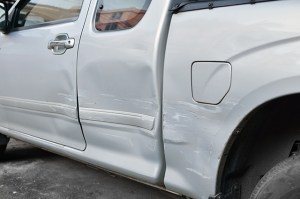While the winter season can bring beauty in the form of fluffy snow and glittering ice, it can also bring hazards. Around your home and while you’re driving, winter precipitation poses potential dangers like black ice, which can cause slips, slides and spills on walkways, driveways and the road. Learn more about this risk and how to stay safe when the weather forecast calls for slippery conditions.
What Is Black Ice?
Despite its name, black ice is actually clear. It’s often compared to a “glaze” and can form on all kinds of surfaces, especially roads, sidewalks and driveways.
Since black ice is transparent, it coats and blends into whatever it covers, and that’s part of what makes it so dangerous. Black ice is also extremely slippery and has several causes, including freezing rain and the melting and re-freezing of ice and snow.
How Does Black Ice Form?
If roadways are wet and the temperature drops below 32 degrees Fahrenheit, black ice can form. Another cause is when “moisture in the air condenses and forms dew or fog, and then the temperature drops below freezing,” according to The Weather Channel. Sometimes, black ice occurs on highways when the heat of tires on the asphalt mixes with freezing conditions.
Keeping an eye on weather reports is a must in the winter, and investing in your own thermometer isn’t a bad idea either.
Where Does Black Ice Form?
Black ice can form almost anywhere under the right conditions, but some places are more likely to freeze this way compared to others.
“Bridges and overpasses are prone to black ice because cold air is able to flow underneath the road surface, since it is elevated, therefore lowering the pavement temperature,” The Weather Channel explains. “Shaded spots on the road are prone [too,] since they receive less warmth from the sun during the day.”
The roads beneath overpasses and at the bottoms of hills are other common places. Black ice also forms more often during early morning and at night, when there’s no sun and the temperatures tend to be colder.
Around the house, paved driveways and shaded walkways are susceptible to black ice.
How to Recognize Black Ice
One of the most dangerous aspects of black ice — besides being so slick — is that it’s difficult to see. While black ice can sometimes be seen in certain lighting, most of the time, it’s practically invisible. When conditions are slippery, be especially mindful of your surroundings and what is coming up ahead. When the temperature is low, glossy surfaces could potentially mean black ice. Whether you are in the car or on foot, slow down.

Black Ice Protection
Winter can bring many hazards, like damaging winds and heavy snow. To protect your home and vehicles this winter, make sure your insurance policies are up to date. When it comes to car accidents or slips and falls where you’re responsible for personal injury to someone else, these policies should cover you.
“However, unlike the cost of repairing your car, [personal] damages can be much larger,” said Jodi DeSantis, AAA Northeast’s vice president of insurance sales. “That’s why we typically advise our members to consider an umbrella policy that provides additional liability coverage in excess of the coverage provided in someone’s auto or home policy.”
When considering an umbrella policy, there are often coverage limits that need to be met on your policies. Your insurance agent can help you sort out the details.
What to Do in the Car
If the temperature is at or below freezing, try to avoid driving if you can. If you have to be on the road when it’s icy, keep these tips in mind.
Let Your Car Warm Up
Today’s vehicles only need a minute or two to warm up in cold weather. “Unnecessary engine idling wastes fuel, pollutes the air and only warms the engine — not the other mechanical parts of the car,” says John Paul, AAA Car Doctor. It’s best to go easy on the gas until you start to feel heat coming from the vents.
Improve Visibility
Clear your windshield and windows of snow, ice and fog for the best visibility possible.
For your own safety and the consideration of others on the road, it is smart (not to mention against the law in every Northeast state not to) remove snow or debris from your car before driving.
Check Your Tires
Checking the tread on your tires is important, since worn tread will have less traction. Paul advises using a quarter to measure tread. “If the tread depth isn’t up to Washington’s head, the tires should be replaced.” He also suggests winter tires for the best traction. “Tires are the only part of your car that touches the road, so you want them to be in good shape.”
Keeping your car in good shape is one of the most important things you can do to stay safe on the road.
AAA members can save on automotive replacement parts and accessories at NAPA stores.
Leave Extra Time and Space
Leave yourself a little extra time and drive slower than normal during winter journeys. While you should never tailgate, leave ample room between you and other cars when road conditions are slippery. This will give you more time to react to sudden changes in traffic.
What to Do at Home
Preparing your home and property before a snowstorm can save you time, energy and give you peace of mind. Before winter precipitation arrives, make sure gutters and drains are unblocked. This way, melting snow and ice will have a place to go.
In addition to shoveling or snow blowing, one trick is to lay out a sturdy cloth or tarp before the snow or ice comes. You can cover your car, porch, stairs, walkways, etc. and then simply remove the snow-covered cloth or tarp when it’s time to leave the house.
If snow has already fallen, clear the driveway and walkways so the sun can dry away any moisture. If the weather reports are calling for snow, ice or a wintry mix – with no sunshine to be found – consider using an ice melt.
There are lots of snow and ice melt options out there, but you should use them with caution. Some are harmful to pets and the environment and can damage grass, plants and walkways. Though they all have pros and cons, try not to over-salt regardless of which deicer you choose.
If you would like to add some extra grit to your driveway or walkway, you can sprinkle fine gravel, sand, cat litter, coffee grinds and/or wood ash.
Winter can be a divisive topic — people either love it or hate it. Regardless of your sentiment toward the season, you can feel more prepared by being proactive, protecting your assets and staying informed.
Protect your home from black ice-related liabilities and more with AAA home insurance. Learn more.
Do you have a story about an encounter with black ice? Share it with us in the comments.
This article has been updated and republished from a previous version.
10 Thoughts on “What Is Black Ice?”
Leave A Comment
Comments are subject to moderation and may or may not be published at the editor’s discretion. Only comments that are relevant to the article and add value to the Your AAA community will be considered. Comments may be edited for clarity and length.












Walking on a sidewalk, I slipped on black ice… invisible! Broke my arm.
Later saw there was a drainage pipe under the sidewalk. Just like a bridge, most likely to freeze there!
Oh No Kathleen, so sorry this happened to you. … Truly is dangerous out in this freezing weather. .. Please be careful and take care of yourself. … What a way to start the new year!! .. God Bless You!!! .. CC
I have used a volcanic based product called ecoTraction, which is also good for the soil, doesn’t hurt pets, concrete or asphalt, or vegetation.
You forgot one of the more important methods of knowing if there is black ice on the roads and highways.
If the road looks wet or shiny and there is no spray coming off the bottoms of car and truck tires…. IT IS BLACK ICE. It is slick enough to skate on. Slow down very gently and carefully if you haven’t already.
Excellent article. Well done. Thank you.
10 years ago I stepped off a curb, slipped and fell on black ice, broke two ribs.
I didn’t even see the ice as it blended with the road.
I am so careful walking now.
Thank you for sharing your story. We are glad you are okay!
Black ice often has an appearance opposite to wet roads. Wet roads typically are shiny except in the tire tracks, which appear rough. Black ice often appears rough, except in the tire tracks, which appear smooth. At night, use the glare from approaching car lights or the reflections from road signs to spot the roughness. If you spot black ice, gently coast down to 20 MPH or slower, and use hazard flashers.
Garage floors get wet and then ice over. Slipping and falling in your garage can be very very serious. Proceed with caution on winter days.
Never use kitty litter! While it may give you some initial traction, when the snow or ice melts, kitty litter will turn to an obnoxious mud that will be tracked everywhere. I have had some luck with “granite dust”, which is inexpensive and darker in color (absorbs more heat from the sun) and it just washes away into the soil. I do not believe it is harmful to animals or plants. I purchased it at a nursery.